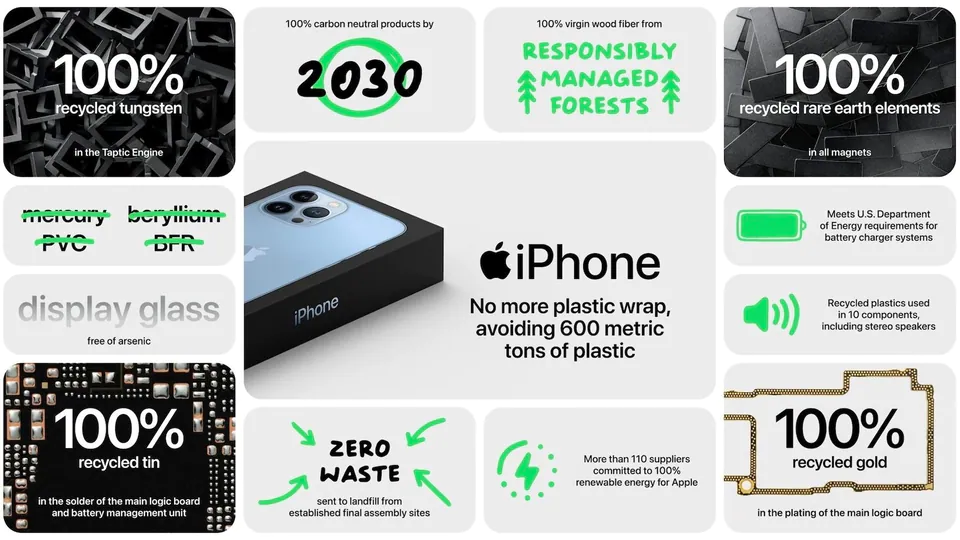Is Apple Sustainable?
Champhei / Shutterstock.com
07 February 2023 – by Eric Koons
Apple has made it clear that it cares about sustainability. Yet, as a technology giant, its climate impacts, carbon footprint and emissions are far-reaching. As with other tech companies, sustainability is often a topic of conversation when the issue of climate change mitigation is brought to the table. Technology companies currently account for 2-3% of global emissions.
Over the last five years, Apple has released several ambitious climate pledges that it has made noticeable progress towards – like being carbon neutral by 2030.
However, as with most technology companies, reaching these targets involves balancing an ever-growing demand for Apple products and the need for sustainability. This is a challenging prospect, but it is also achievable.
What Is Apple Doing for Sustainability?
The core of Apple’s sustainability effort is its goal of being carbon neutral for its products and supply chain by 2030. This is an ambitious yet necessary target and heavily relies on supplier relations. Supply chains are notoriously difficult to decarbonise.
As a result, Apple is working directly with suppliers to help decarbonise its corporate operations around the world. This is mostly done by implementing renewables and increasing manufacturing efficiency. Since Apple released this goal in 2020, its global suppliers have added 10 GW of renewable energy capacity.
Overall, Apple is making some positive strides toward this target. In 2021, Apple emitted 23.2 million tonnes of carbon dioxide. This number may seem high, but it represents a significant reduction compared to its 2015 CO2 emissions of 38.4 million tonnes.

However, we need to take this reduction with a grain of salt. It is heavily influenced by the company’s purchase of carbon offsets, which offset about half of its emissions.
If we view emissions without considering the company’s use of offsets, Apple’s overall emissions have actually increased since 2015. While carbon offsets can play an important role in sustainability, particularly for hard-to-abate industries, they do not entirely replace direct reductions.

How Else Is Apple Contributing To Its Sustainability Goals?
In pursuit of its 2030 net-zero target, Apple is making changes throughout the company and making its approach publicly available. Beyond increasing renewable energy use, its main focus areas are:
- Low-carbon Design: changing Apple devices designs to reduce carbon emissions by increasing recycled materials, improving design efficiency (fewer materials required), and improving product energy efficiency.
- Avoiding Direct Emissions: finding alternative manufacturing and shipping processes that reduce direct emissions.
- Carbon Removal: investing in carbon offsets and sequestration programs to reduce overall emissions that it can’t yet avoid. This includes investing in programs restoring natural ecosystems and preserving undeveloped areas.
- Energy Efficiency: increasing energy efficiency in stores, data centers and manufacturing facilities.
Is Apple A Sustainable Company?
Do these programs make Apple a sustainable company? No clear threshold gives this distinction, so we have to look at other indicators.
First, Apple has issued USD 4.7 billion in green bonds since 2016, which it will use to support its net-zero initiative. At first glance, this may seem like a significant number. But, the value of the bonds only equates to around 1.2% of the company’s annual revenue in 2022, or 0.2% of its revenue from 2016 to the present.

However, Apple can’t be expected to spend most of its revenue on green initiatives. It is a publicly traded company that has the responsibility of turning a profit for its shareholders. Additionally, the company can do a lot of good with USD 4.7 billion. However, to put it into perspective, this is about 5% of what South Korea plans to spend on its “Green New Deal” over the next six years.
Comparing Industry Leaders: Apple Is On Top
Comparing Apple to its competitors gives an idea of the level of sustainability in the technology industry as a whole. In this sense, it appears that apple is leading the charge. A report by Counterpoint Research named Apple as the most sustainable smartphone company. However, it did note that no smartphone companies were doing enough – in its opinion.

Regardless, there is still room for Apple to improve, and it is time to nudge the company to do more. If it can reach its sustainability targets and continue to release more ambitious goals, then it may be time to deem them sustainable. In simple terms, the company isn’t sustainable yet, and it’s still too early to tell if it will be sustainable in the future.
The Role of Apple and Other Tech Giants in the Green Transition
Beyond the fact that the technology industry has a noticeable impact on global emissions, it also influences the environment differently. Growing quantities of e-waste, mining for rare metals and increasing labor and human rights demands are all factors to consider.
Apple is the largest US company by market cap and has significant influence in all industries. It should be using this clout to promote sustainability within all marketplaces.
The role of Apple and other tech giants is not just to make itself sustainable but also to help the world be sustainable.
by Eric Koons
Eric is a passionate environmental advocate that believes renewable energy is a key piece in meeting the world’s growing energy demands. He received an environmental science degree from the University of California and has worked to promote environmentally and socially sustainable practices since. Eric’s expertise extends across the environmental field, yet he maintains a strong focus on renewable energy. His work has been featured by leading environmental organizations, such as World Resources Institute and Hitachi ABB Power Grids.
Read more



